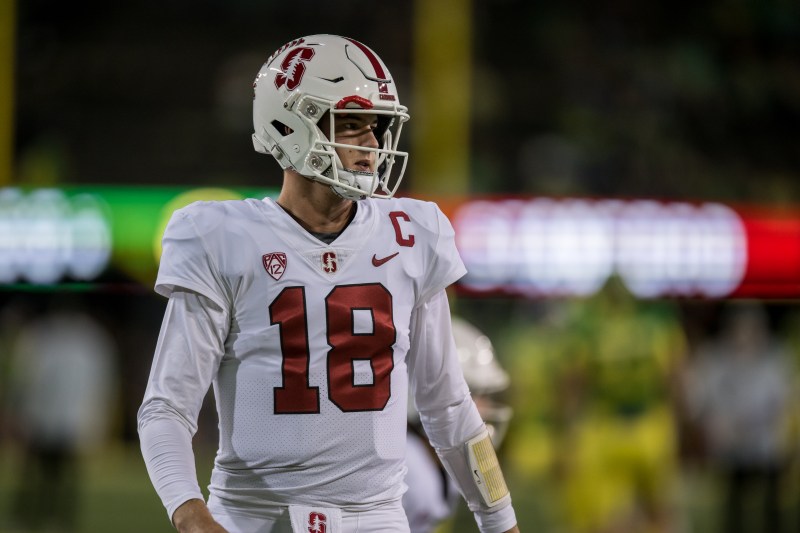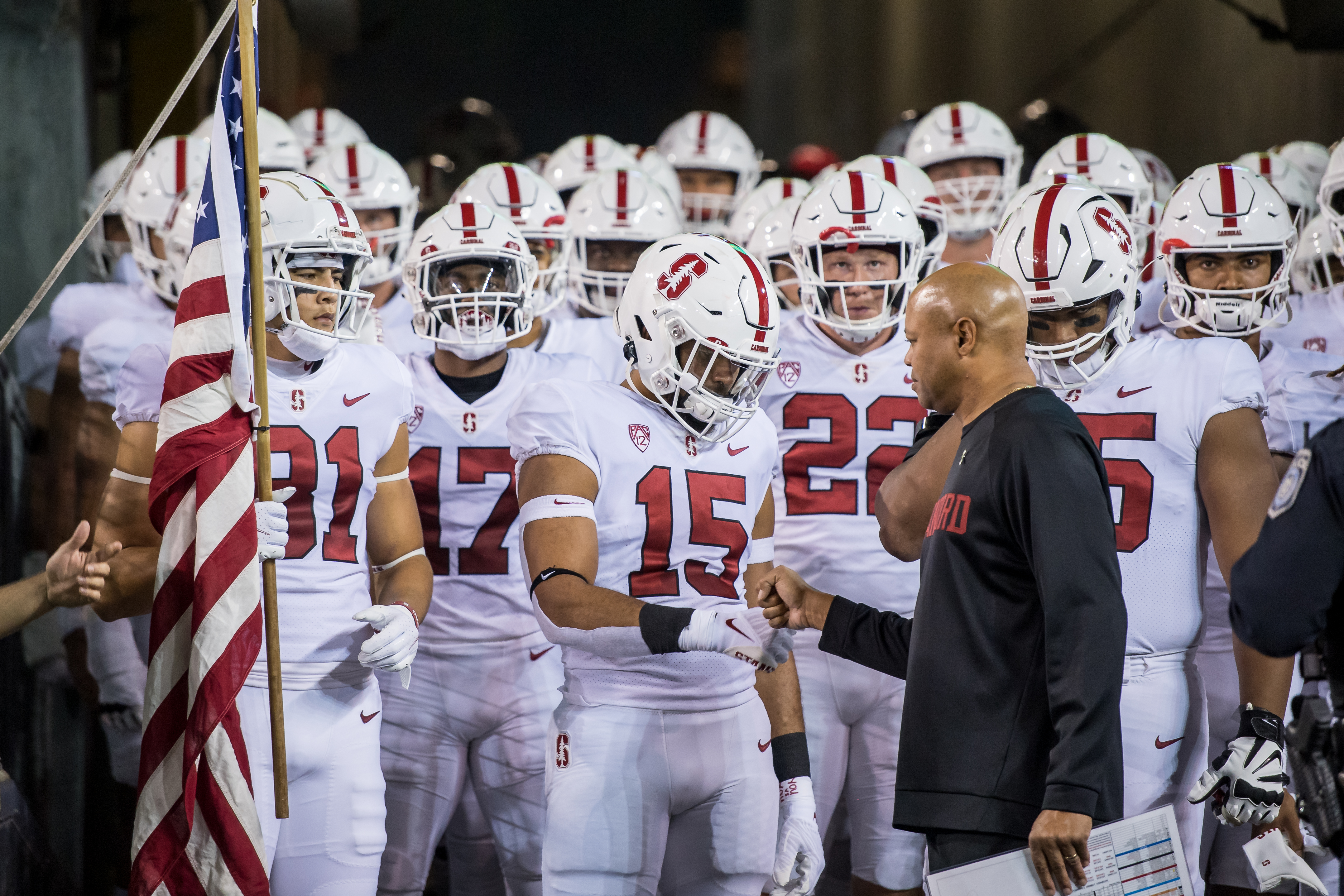Between the third and fourth quarter, the Oregon PA plays the song “Shout.” Everybody at Autzen Stadium takes out their phone flashlight, jumps around and sings along at the top of their lungs. The Oregon fans were having a ball during “Shout” last Saturday, but it was a tough experience firsthand: Stanford fans sat quietly, watching their team getting blown out again in conference play.
The fact that Stanford football (1-3, 0-3 Pac-12) fell 45-27 to the then-No. 13 Oregon Ducks (4-1, 2-0 Pac-12) on the road, with an injury-ravaged offensive line, is not surprising. Nor is it, as a sole data point, something to which Cardinal fans should be overly anchored. But the unhappy feeling of defeat has gotten all too familiar of late, as the Cardinal are now over a calendar year removed from an FBS win. Saturday’s game against Oregon State (3-2, 0-2 Pac-12), then, is all about ending this unfortunate streak, and leaving that uncomfortable losing feeling behind — lest it become self-fulfilling.
In the Oregon post-game press conference, head coach David Shaw rejected the notion that Oregon State is a must win game for the 2022 vintage of Stanford football. Perhaps, but it is difficult to draw a path to bowl eligibility without winning Saturday, in the first home game of the academic year.
It’s not worth breaking down the Oregon game here. They are a team with Rose Bowl aspirations. Familiar themes like injuries, poor pass protection, a slow offensive start, trouble with mobile quarterbacks and the inability to stop the run all bit the Cardinal over the course of the game. Instead, let’s turn the page and look ahead to Oregon State.
The Beavers are a fascinating opponent. For so long the doormat of the Pac-12, the Beavers have quietly improved markedly in the last couple years. They are a physical football team that will run the ball and run it again. They should have beaten top-10 USC (5-0, 3-0 Pac-12): the Beavers ultimately fell 17-14 because of untimely interceptions but to date are the only team to have slowed the Trojans’ offense. Similar poor quarterback play doomed them against No. 11 Utah (4-1, 2-0 Pac-12) last week — if they had a better quarterback, they would be a legitimate threat at the top of the conference.
Nevertheless, as good as Oregon State’s other 21 starters may be, below-average quarterback play can doom a football team. Hence, Saturday’s game is tough to call. The Beavers will be physical and will pound the rock on the ground — Stanford will not find it easy whatsoever. Nevertheless, that one-dimensionality plays into Stanford’s hands defensively. Indeed, one of Stanford’s best outings on a yard-per-run allowed basis last year was the game in Corvallis as the Cardinal allowed 4.3 yards per carry, well below the season average of 5.9.
Moreover, this is a Stanford team absolutely with its back against the wall, desperate for a win. Needless to say, the players will be fired up.
Hence, a lot to look forward to on Saturday: we’re going to learn a lot about this team. Can Stanford arrest its slide? Hard to say, but the Cardinal should keep the following in mind to avoid dropping 11 FBS contests in a row.
- Get the downfield passing attack going
Through four games, Stanford’s passing attack has felt like less than the sum of its talented parts. Some of that is inconsistent line play, exacerbated by the injury crisis that led to sophomore Jack Leyrer playing nearly all of the game in Eugene out of position at right tackle in his Stanford debut. But perhaps some of the passing woes are schematic.
We really haven’t seen Stanford successfully and consistently move the ball downfield, which is surprising given how adept junior quarterback Tanner McKee is at vertical throws both over the middle and down the sideline. McKee has elite arm talent: last week, senior wide receiver Elijah Higgins hauled in a beautiful, pro-level throw in the third quarter on his 28-yard touchdown reception that serves as a great reminder of that skill. It also highlighted how little we have seen, for example, Higgins and junior tight end Benjamin Yurosek leverage their size and speed to create mismatches with safeties, nickelbacks or others down the field to exploit, as Higgins did on his touchdown.

Instead, so much of Stanford’s passing attack is short: quick crossers, screens and hitches at the sticks. Look back at the fourth quarter turnover on downs. On fourth and long, Higgins was the primary receiver and ran a two yard in-breaking route. Unsurprisingly the Cardinal did not convert. Such staples feel a bit stale, and time and time again opponent defensive backs will sink to the sticks on third down and just await routes like the hitch (which Oregon defensive backs were especially attuned to). And of course, in football, everything is related: throw more downfield and now opponents cannot be as aggressive on the short stuff, which should then improve.
- Sell out to stop the run
Stanford has not stopped the run in Pac-12 play. The defensive front is both undersized and inexperienced, and thus significant reinforcements are needed on run fits.
Unfortunately, each of USC, No. 21 Washington (4-1, 1-1 Pac-12) and Oregon has had dangerous passing attacks, challenging Stanford corners and forcing safeties to play high to prevent big plays. As a corollary, Stanford presented light box counts, which opponents have leveraged to devastating effect on the ground — for instance, Oregon’s 9.5 yards-per-carry last weekend.
Oregon State, by virtue of middling quarterback play and a less-talented arsenal of receivers, does not provide the same credible passing threat. As such, Stanford can play with more defenders close to the line of scrimmage. And at this point, the Cardinal really have no option. Dial up run blitzes. Leave the corners on islands. Commit to doing whatever it takes to stop the run. If Oregon State beats Stanford through the air, so be it. But, if Stanford does not adjust, the Beavers will win on the ground.
- Get the home fans into it
The first game of the academic year means Saturday’s matchup will be the first taste of college football action for nearly two thousand freshmen in the stands. Historically, the student turnout for the first game is high: UCLA last year even set an attendance record for students. Stanford Stadium, so often unfairly maligned for its atmosphere, will have the student section necessary to will Stanford on.
To get the home atmosphere really dialed up, though, the Cardinal need to start fast — something the team has struggled with in conference play this year. A Tanner McKee interception against USC and three-and-outs (following a sack) versus Washington and Oregon have spoiled David Shaw’s strategy of always receiving the opening kick.
Beyond the first series, though, Stanford need to find themselves in a competitive game early. The feeling of “oh boy, here we go again” on struggling teams is toxic and self-fulfilling — as NFL wide receiver Jarvis Landry once ranted on HBO’s Hard Knocks, it’s “contagious.” The last thing a Stanford team desperate to turn the corner needs is to get into an early hole and face a flat home atmosphere and that sense of deja vu that has become all too familiar over the losing streak.
Pablo’s Predictions of the Week:
- Oregon State 27, Stanford 24
- Game I’ll be watching: (17) TCU @ (19) Kansas — what a story the Jayhawks are!
- Upset of the week: (11) Utah @ (18) UCLA
Pablo will be in the booth Saturday to call the game on KZSU.
